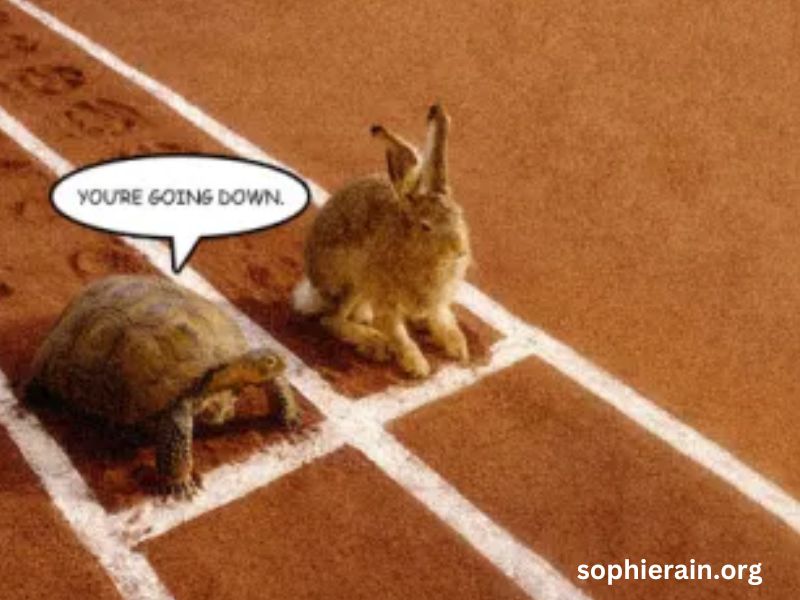In today’s fast-paced world, where efficiency and speed are highly valued, the age-old fable of “The Tortoise and the Hare” continues to resonate deeply. This classic story has now evolved into a meme about overconfidence, serving as a metaphor for how arrogance, impulsiveness, and underestimation of others can lead to failure. The tortoise and hare story goes beyond being just a children’s tale; it has grown into a powerful life lesson on humility, persistence, and the dangers of overconfidence. The “tortoise and the hare overconfidence meme” captures these themes and has become an insightful reflection of real-world behavior, from workplaces to personal growth, and even competitive environments like sports.
The Origin of the Tortoise and the Hare Fable
The story of “The Tortoise and the Hare” originated as part of Aesop’s fables, a collection of moral tales attributed to a Greek storyteller, Aesop, who lived around 600 BCE. The narrative is simple: a hare, full of arrogance and self-assurance, challenges a slow-moving tortoise to a race. Confident in his natural speed and ability, the hare quickly pulls ahead and, feeling certain of his victory, decides to take a nap midway through the race. The tortoise, slow but steady, continues moving forward and eventually wins the race while the hare is still asleep. The fable teaches the timeless lesson that “slow and steady wins the race” and warns against the perils of overconfidence.
The Modern Meme: Tortoise and the Hare Overconfidence Meme
Fast forward to the present day, and the story of the tortoise and the hare has been immortalized in various formats, particularly through the lens of internet culture. Memes have transformed this fable into a visual metaphor for situations where overconfidence leads to unexpected failure, and perseverance leads to success. The “tortoise and hare overconfidence meme” typically portrays the hare as someone who is overly self-assured and dismissive of challenges, only to lose in the end because of that same arrogance.
This meme resonates because of its applicability to modern-day life. In today’s competitive world, we often see individuals or companies who are the “hare”—those who start fast, move with great confidence, and then slow down due to distractions or a lack of sustained effort. Meanwhile, the “tortoise” represents those who maintain focus, work methodically, and ultimately surpass the competition. The overconfidence meme encapsulates how many high-performing individuals, teams, or organizations can fall victim to their own sense of superiority.
The Role of Overconfidence in Failure
Overconfidence is a psychological bias where an individual overestimates their own abilities or underestimates the challenges they face. In the tortoise and the hare meme, this is perfectly embodied by the hare’s decision to take a nap during the race. His belief that his speed alone guarantees success blinds him to the possibility that the slower tortoise could win. This overestimation of ability is a common mistake in many aspects of life.
In the workplace, for example, overconfidence can lead to poor decision-making. Employees or leaders who are overconfident may neglect to double-check their work or fail to consider potential risks, assuming that their knowledge and skills are infallible. As a result, projects can fail or important opportunities can be missed. The tortoise and hare meme serves as a humorous reminder of how dangerous it is to be too sure of oneself, especially in high-stakes situations.
Similarly, in personal development, individuals who rely too heavily on natural talent or past successes may find themselves lagging behind those who consistently put in the effort to improve. Overconfident people may dismiss the need for ongoing learning or underestimate the competition, leading to complacency and eventual failure. The “tortoise” in this case represents the person who values persistence, lifelong learning, and incremental progress.
The Tortoise’s Steady Approach: A Blueprint for Success
On the other hand, the tortoise’s slow and steady approach is a metaphor for persistence, consistency, and long-term thinking. While the hare’s overconfidence caused his downfall, the tortoise’s unwavering determination and focus on progress led him to victory. This mirrors many real-world success stories, where slow but consistent effort outperforms sporadic bursts of brilliance.
In entrepreneurship, for example, many successful companies are built on long-term strategies, careful planning, and a focus on sustainable growth. While some start-ups may experience rapid initial success (much like the hare), those that are built with the tortoise mindset—focused on incremental progress, continuous improvement, and avoiding the pitfalls of overconfidence—tend to last longer and achieve greater stability in the long run.
Real-World Examples of the Tortoise and the Hare Phenomenon
In sports, we see frequent examples of the tortoise and hare dynamic. Teams or athletes who enter a game overconfident, perhaps due to past victories or superior rankings, sometimes underperform against an underdog who plays with determination and grit. The “tortoise and hare overconfidence meme” often pops up after major sporting events where an unexpected team triumphs over a seemingly unbeatable opponent. In these cases, the meme humorously reflects how overconfidence can lead even the most talented teams to defeat.
In the business world, companies like Blockbuster and Kodak are often viewed as “hares” who became overconfident in their dominance. They failed to adapt to changing market conditions, while companies like Netflix and digital photography startups—the “tortoises” in these situations—slowly and steadily innovated and ultimately took over the market. These real-world cases highlight the dangers of resting on one’s laurels and underestimating the competition.
Overconfidence in Personal Development
On a personal level, the “tortoise and hare” meme can be applied to personal growth and achievement. Many people start their self-improvement journeys with enthusiasm but eventually burn out due to overconfidence in their initial results. The hare, in this case, represents those who seek quick fixes or short-term success without recognizing the importance of consistent effort over time. The tortoise, by contrast, symbolizes individuals who prioritize long-term growth and avoid the trap of overconfidence.
For instance, when learning a new skill, the tortoise’s methodical approach—focusing on steady practice and consistent improvement—often leads to greater mastery than the hare’s tendency to rush through the basics in pursuit of immediate results. The overconfidence meme reminds us that success often comes to those who maintain patience and perseverance, even when the path seems slow.
Why Overconfidence Fails and Perseverance Wins
The “tortoise and hare overconfidence meme” illustrates the idea that raw talent and speed are not the sole determinants of success. Often, overconfidence causes individuals to overlook essential elements like preparation, hard work, and humility. The hare’s decision to sleep during the race represents the failure to respect the process and maintain focus. On the other hand, the tortoise’s steady movement exemplifies the power of perseverance and incremental progress, which ultimately leads to victory.
The meme resonates deeply in competitive fields like technology, education, and fitness, where the fast movers may initially appear to have the upper hand. However, those who adopt a “tortoise” mentality—continuing to move forward, adapting to challenges, and focusing on steady improvement—often end up surpassing those who rely solely on speed or overestimate their abilities.
Conclusion: The Enduring Lesson of the Tortoise and the Hare
In conclusion, the “tortoise and hare overconfidence meme” serves as a humorous yet insightful reminder that overconfidence is often the undoing of those who rely too heavily on their natural talents or prior success. The tortoise’s slow, steady progress is a valuable lesson in perseverance, focus, and humility. Whether in professional settings, personal development, or competitive environments, the tortoise’s approach to life offers a blueprint for long-term success, while the hare’s overconfidence highlights the dangers of arrogance and complacency.






